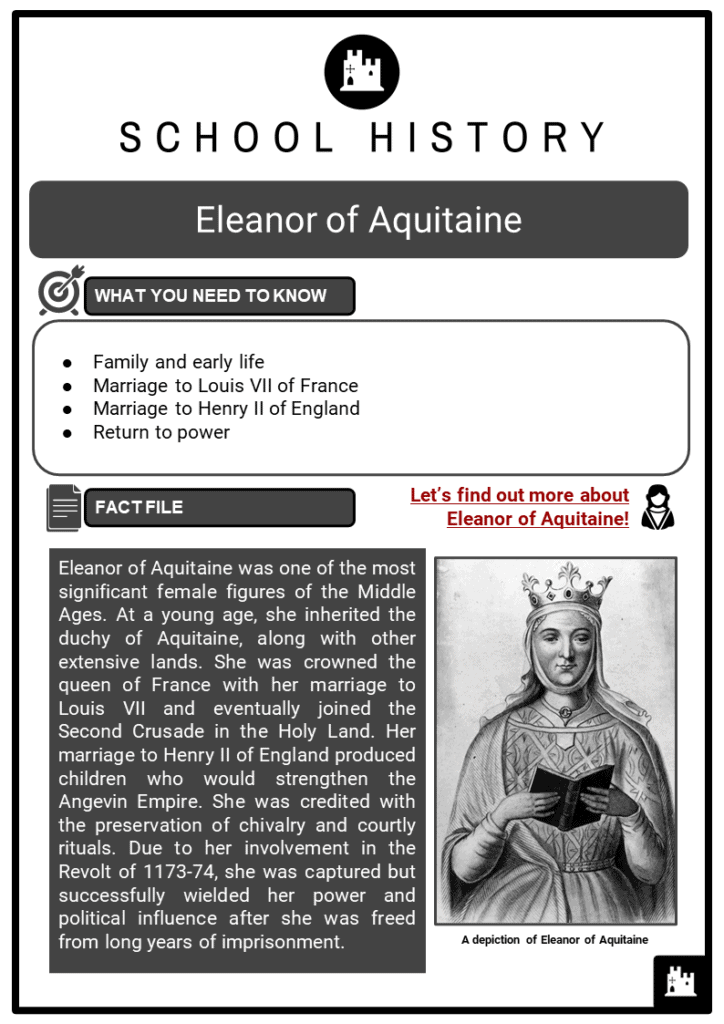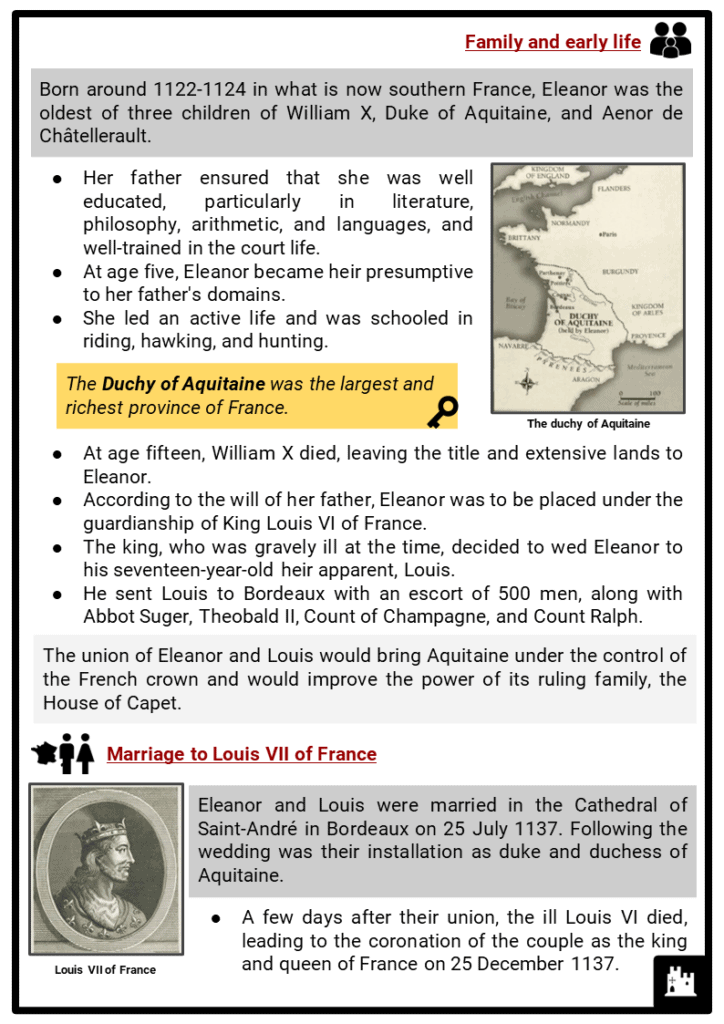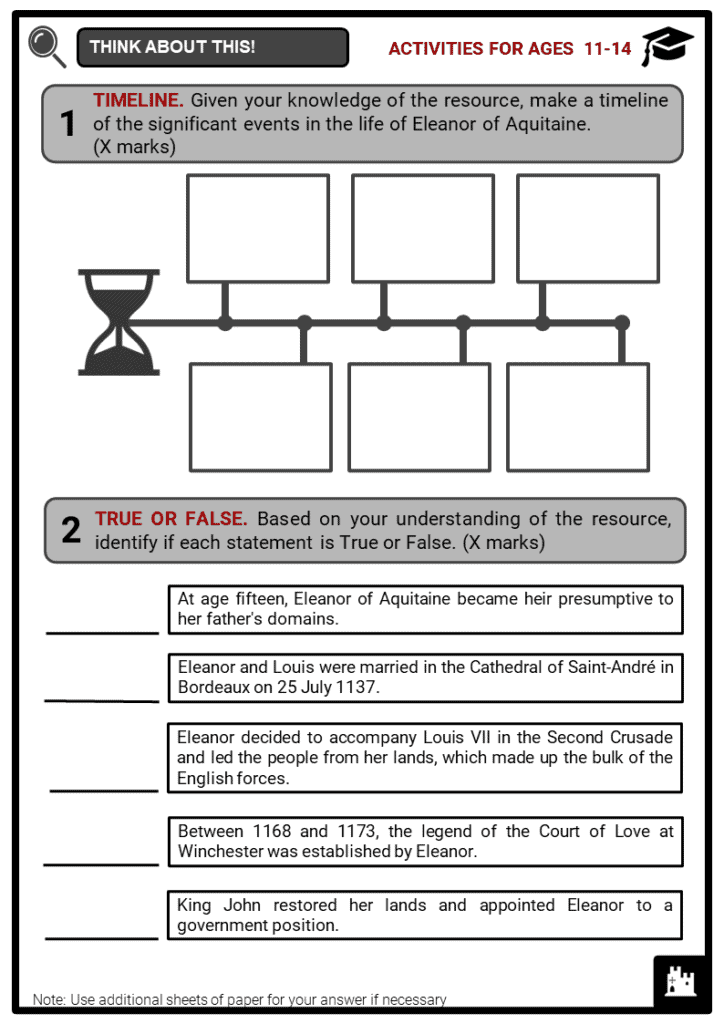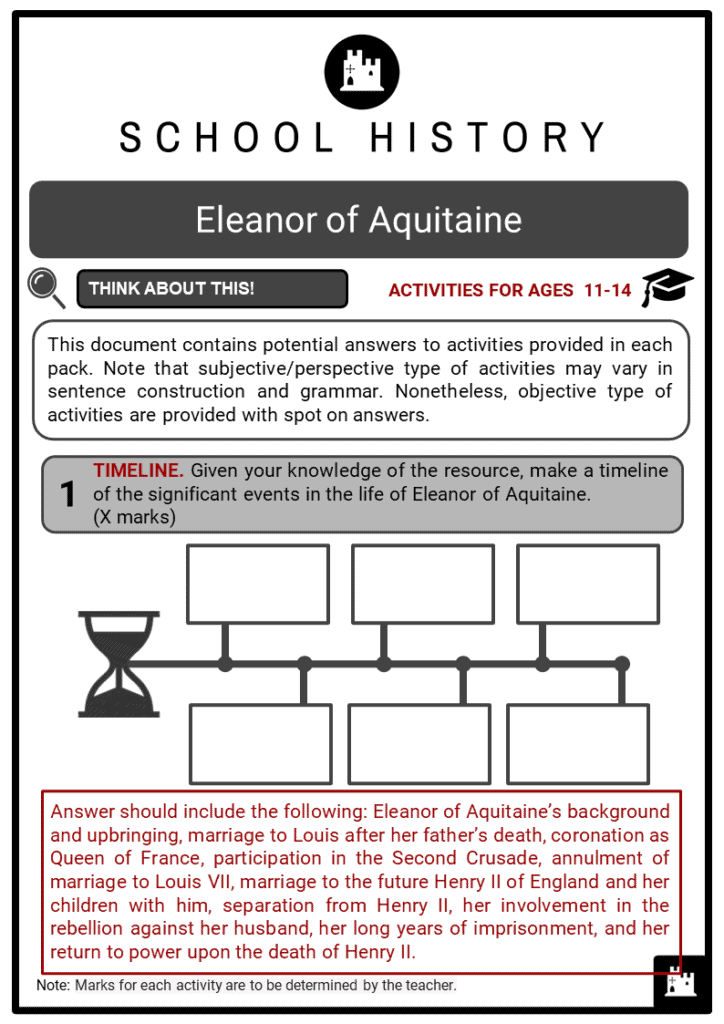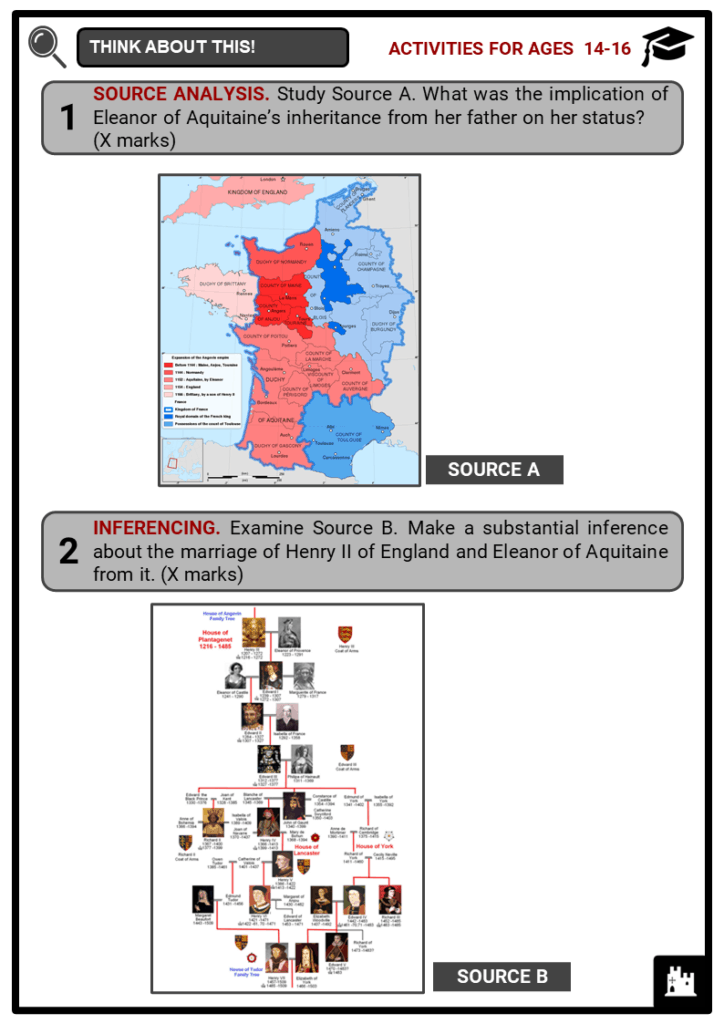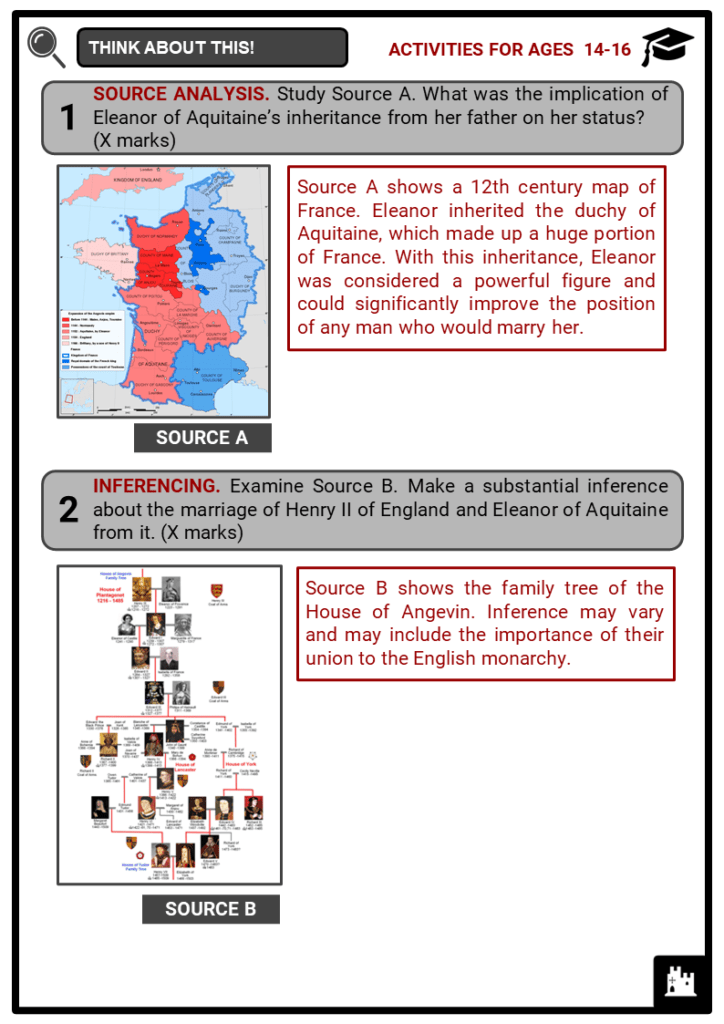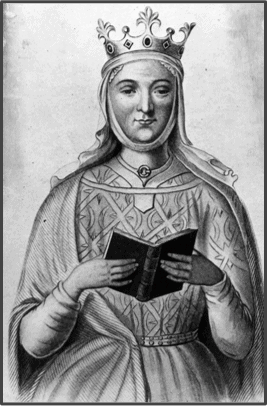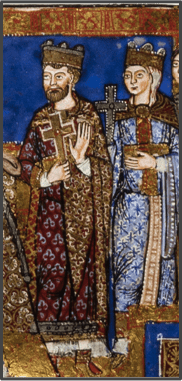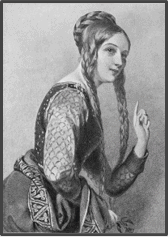Download Eleanor of Aquitaine Worksheets
Do you want to save dozens of hours in time? Get your evenings and weekends back? Be able to teach Eleanor of Aquitaine to your students?
Our worksheet bundle includes a fact file and printable worksheets and student activities. Perfect for both the classroom and homeschooling!
Table of Contents
Add a header to begin generating the table of contents
Summary
- Family and early life
- Marriage to Louis VII of France
- Marriage to Henry II of England
- Return to power
Key Facts And Information
Let’s find out more about Eleanor of Aquitaine!
- Eleanor of Aquitaine was one of the most significant female figures of the Middle Ages. At a young age, she inherited the duchy of Aquitaine, along with other extensive lands. She was crowned the queen of France with her marriage to Louis VII and eventually joined the Second Crusade in the Holy Land. Her marriage to Henry II of England produced children who would strengthen the Angevin Empire. She was credited with the preservation of chivalry and courtly rituals. Due to her involvement in the Revolt of 1173-74, she was captured but successfully wielded her power and political influence after she was freed from long years of imprisonment.
Family and early life
- Born around 1122-1124 in what is now southern France, Eleanor was the oldest of three children of William X, Duke of Aquitaine, and Aenor de Châtellerault.
- Her father ensured that she was well educated, particularly in literature, philosophy, arithmetic, and languages, and well-trained in the court life.
- At age five, Eleanor became heir presumptive to her father's domains.
- She led an active life and was schooled in riding, hawking, and hunting.
- The Duchy of Aquitaine was the largest and richest province of France.
- At age fifteen, William X died, leaving the title and extensive lands to Eleanor.
- According to the will of her father, Eleanor was to be placed under the guardianship of King Louis VI of France.
- The king, who was gravely ill at the time, decided to wed Eleanor to his seventeen-year-old heir apparent, Louis.
- He sent Louis to Bordeaux with an escort of 500 men, along with Abbot Suger, Theobald II, Count of Champagne, and Count Ralph.
- The union of Eleanor and Louis would bring Aquitaine under the control of the French crown and would improve the power of its ruling family, the House of Capet.
Marriage to Louis VII of France
- Eleanor and Louis were married in the Cathedral of Saint-André in Bordeaux on 25 July 1137. Following the wedding was their installation as duke and duchess of Aquitaine.
- A few days after their union, the ill Louis VI died, leading to the coronation of the couple as the king and queen of France on 25 December 1137.
- Eleanor moved to her new home, the unwelcoming Cîté Palace in Paris, which was made comfortable for her.
- The new king Louis VII was very much in love with her. On the contrary, the people were critical of her conduct.
- The early years of their marriage were marked with power struggles with their own vassals, and conflict with the Pope in Rome.
- Louis came into a conflict with Pope Innocent II when he attempted to place his loyal supporter in the vacant archbishopric of Bourges, instead of Pierre de la Châtre, the preferred candidate of the canons and the Pope.
- The Pope, claiming that the king was only a child, blamed the act on Eleanor whose father made similar attempts.
- This led to an interdict imposed upon the king's lands.
- An interdict is an ecclesiastical censure that prohibits individuals or groups from participating in certain rites and services of the Church.
- In 1142, the king was also involved in a conflict with Count Theobald caused by his support for the marriage of Petronilla, Eleanor's sister, to Raoul I, Count of Vermandois.
- Raoul I had to leave his wife Eleanor of Blois, Theobald's sister, to marry Petronilla.
- War between Theobald and Louis broke out and led to the occupation of Champagne by the royal army, and to the burning of the small town of Vitry-en-Perthois in 1143, killing as many as 1,500 people.
- The king's actions were condemned by the Church.
- The war ended in peace in 1144 with the return of Champagne to Theobald and the acceptance of Pierre de la Châtre as the archbishop of Bourges.
- Hounded by guilt, Louis vowed to mount a Crusade to atone for his role in the massacre in the town of Vitry.
- The Crusades were a series of religious wars between Christians and Muslims, started primarily to secure control of holy sites.
- Louis responded to Pope Eugene III's call for an expedition to safeguard the former conquests in the East, and take back the Armenian city of Edessa.
- He joined German king Conrad III.
- Eleanor decided to come and led the people from her lands, which made up the bulk of the French forces.
- Eleanor's entourage was criticised and was blamed for the failure of the Crusade. However, it was Louis' incompetent strategy that jeopardised the Crusade.
- The marriage of Louis and Eleanor was pushed to the breaking point over the course of the disastrous Second Crusade.
- They sailed back to France in 1149.
- The pope attempted to reconcile them but failed.
- Their marriage was then declared void for reasons of consanguinity on 21 March 1152, leaving their two daughters Marie and Alix in Louis' custody.
Marriage to Henry II of England
- Duchess Eleanor was only 28 at the time of their annulment, and powerful men were interested to marry her. Upon her arrival in Poitiers, she secretly sent for Henry II, Duke of Normandy, to marry her. Only eight weeks after the separation, the two were married on 18 May 1152.
- Henry was the son of Geoffrey Plantagenet and Matilda, daughter of Henry I of England.
- Like his mother who fought for control of England, he had his eyes on the English throne.
- Whilst genealogy suggests that he was more closely related to Eleanor than her previous husband, this did not prevent the union.
- Henry became Duke of Aquitaine and with Eleanor, held Normandy, Anjou, Maine, and Touraine.
- Eleanor was crowned queen of England following Henry II's succession to the English throne on 25 October 1154.
- Their marriage produced five sons and three daughters namely William, Henry, Richard, Geoffrey, John, Matilda, Eleanor, and Joan.
- The early years of their union were strong as Henry II restored royal administration, reestablished hegemony over Wales and gained full control over his lands in Anjou, Maine and Touraine.
- The king, who often traveled to different parts of his realm, appointed Eleanor as regent.
- Henry II and Eleanor were able to strengthen the Angevin Empire with their children and their marriages.
- By 1167, Eleanor's relationship with Henry II was strained and the queen decided to move her household to her own lands at Poitiers.
- Between 1168 and 1173, the legend of the Court of Love at Poitiers was established by Eleanor, who was possibly accompanied by her daughter Marie.
- In the Court of Love, it was believed that they encouraged the ideas of troubadours, chivalry, and courtly love, which had extensive significance on literature, poetry, music and folklore.
- Due to the nature of the court, it is thought to have attracted artists and poets, contributing to a boom of culture and the arts.
- However, it appeared to have failed to survive when Eleanor was captured and imprisoned from 1173.
- In 1173, Henry the Young King, with the aid of his surviving brothers, Richard and Geoffrey, launched a revolt against their father, which came to be known as the Revolt of 1173-74.
- Eleanor is thought to have encouraged her sons and the lords of the south to rise up and support them.
- However, Henry II successfully managed the resistance, leading to the arrest of Eleanor and her imprisonment for the next sixteen years.
- Eleanor was moved to various locations in England, and was unable to see her children often during her imprisonment.
- Whilst imprisoned, her son, Henry the Young King, attempted again to replace Henry II in 1183. Again, he was unsuccessful and fell ill after fleeing.
- Before dying, he begged his father to show mercy to his mother.
- The death of Henry the Young King was followed by the beginning of a period of greater freedom for Eleanor.
- Still supervised, she traveled with Henry II, and at times was involved in the administration of the realm.
Return to power
- When Henry II died in July 1189, Richard the Lionheart succeeded to the English throne, thereby ordering the release of his mother, Eleanor. The new king restored her lands and appointed Eleanor to a government position.
- Eleanor remained involved in the management of her lands.
- She was responsible for setting up the marriage of Richard to Berengaria of Navarre and taking over political duties when her son was crusading in the Holy Land.
- When the king was captured by the Holy Roman Emperor Henry VI, it was her who arranged for the king's release.
- She went on to live into the reign of her youngest son, John, and continued to exercise a considerable degree of influence over the affairs of England.
- Already in her 70s, she pursued the strengthening of the bonds between the Plantagenets and the Capets by arranging the marriage of her granddaughter Blanche with the son of the French king.
- At around age 80, Eleanor died in 1204 having outlived most of her children. She was buried in Fontevraud Abbey next to her husband Henry and her son Richard.
Image sources:

